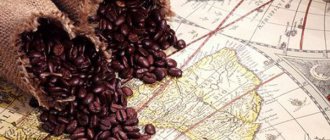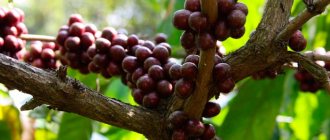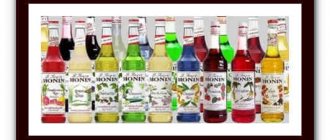Coffee producers are Germany, France and Italy. But in fact they are not. There are no coffee trees in Europe. In these countries, grain raw materials are fried, ground and packaged in jars, boxes, and bags. Countries where coffee grows include America, Africa, Asia, and Australia. From there, processed and dried green grains are transported to European factories.
Historical reference
People knew about the tonic and invigorating properties of the fruits of the coffee tree already in the 9th century. Then the berries were consumed raw, in pure form or with animal fat and milk.
Over time, people learned to prepare a tincture from the peel and pulp of the fruit. Coffee in its usual form from ground beans appeared in the 13th century.
Find out more in the article “What is coffee: the history and homeland of the aromatic drink.”
Asia, Australia and Oceania
Australia - medium density, moderate acidity, delicate, juicy taste
Bali, Indonesia - high body, low acidity, creamy, nutty, chocolate, vanilla and earthy notes
Hawaii, USA - medium body, low acidity, very balanced taste with notes of vanilla, cream and brown sugar
India - high density, moderate acidity, tropical, fruity notes. Monsoon Malabar has a very intense flavor with slight sourness and notes of tobacco.
Myanmar - medium density, moderate acidity, reminiscent of Brazilian coffee
Papua New Guinea - medium body, moderate acidity, fruity and earthy notes
Sulawesi, Indonesia - high body, low acidity, herbal, spicy and woody notes
Sumatra, Indonesia - high body, low acidity, intense flavor with woody, earthy and sandy notes
Timor, Indonesia - high body, low acidity, floral, woody, herbal and earthy notes
Java, Indonesia - high density, low acidity, chocolate, cream and nutty notes
Varieties
There are 90 species of coffee trees from the madder family in the world. 20 of them bear fruits that are suitable for consumption. And people collect grains from only two species, which they supply to factories.
Arabica: an Arabian variety that grows in high mountain areas up to 2500 meters above sea level. It has a rich aroma. Despite difficulties in cultivation, coffee is the leader in exports - 60% of all types.
Robusta: Congolese variety, undemanding to living conditions. Contains twice as much caffeine as Arabica. Less aromatic, therefore less valuable. It makes up 20% of the total volume of coffee beans grown.
Other varieties: Arabusta, Liberica, Excelsa. Details in the article “Name and characteristics of coffee varieties.”
Under what conditions does coffee grow?
Large yields and high taste qualities of the product are obtained from plants grown under certain conditions.
The coffee tree grows best in:
- Soft, oxygenated soil, acidic environment. Plantations where coffee is grown are located on high mountain slopes with soil of volcanic origin.
- Stable climate. Sudden temperature changes are detrimental to this plant, which is why the coffee tree is grown only in the equatorial zone.
- An environment with a certain level of humidity. The optimal precipitation rate is from 3000 mm/year.
- Located high above sea level. The quality of the resulting raw materials depends on this parameter. The best are grown on plantations located at an altitude of 2000 m above sea level.
- Warm weather. Plants prefer a certain air temperature: 18 to 23 °C is considered ideal, and 13 to 27 °C is acceptable. Hot weather accelerates the ripening of berries, which deteriorates the taste of the grains.
- Abundant lighting. There is a nuance: direct sunlight should not fall on the plant, the lighting should be diffused. Therefore, plants are planted in areas shaded by taller trees with dense foliage.
The coffee tree is susceptible to diseases, the most dangerous of which is rust. This fungal disease destroys crops and can ruin plantings.
Coffee belt
Optimal conditions
The homeland of coffee trees is Ethiopia and the territory of modern Yemen, which is located on the Arabian Peninsula. Here these plants grew wild.
The following climatic conditions are necessary for tree growth and fruit ripening:
- average annual air temperature - 20°C;
- precipitation - 1000-1800mm per year;
- Some trees require high altitudes.
Interesting! Instant coffee - composition, properties, health effects
These conditions correspond to a tropical climate. In other climatic zones, coffee trees are found as ornamental non-fruit-bearing plants. Whether coffee grows on mountain slopes or in valleys determines its taste and smell.
Belt coverage area
Regions that have suitable climatic conditions for growing coffee trees are located along the equator. They move away from it at 20° north and south latitude. The corridor, which is limited by these latitudes, encircles the planet. Hence the name coffee belt of the earth.
According to the world map, the belt covers the territories of South and Central America, Central Africa, Southeast Asia, Australia, New Zealand and the islands of Oceania. In total, there are 80 countries where coffee is grown. But only 50 of them are world exporters.
The turnover of coffee raw materials is 5 million tons per year. There are leaders in this market - coffee producing countries. The harvest is measured in bales, each containing 60 kg of green grains.
Let's look at which countries coffee is grown in.
The birthplace of the coffee tree and the history of the origin of the drink
The birthplace of coffee is the African continent. Arabica (Arabian coffee tree) was found in the fourteenth century in the largest country in Africa - Ethiopia. Robusta (Congolese coffee tree) was discovered much later, in the nineteenth century in the Congo River basin. Although, according to legends, he was known long before that.
Arabica tree in the wild of Ethiopia
The history of coffee began with simply drying coffee fruits in the sun and brewing their peels as tea.
. Also, a heady drink reminiscent of wine was prepared from fresh grains by fermentation. It was used mainly by the poor population. By the fifteenth century, thanks to travelers, this product began to spread throughout the eastern countries, and later came to Europe.
Over time, coffee preparation has improved, and technologies for roasting, grinding beans and brewing have been developed. After this, rich and noble people drew attention to the unusual, invigorating drink. In the sixteenth century, mass consumption of the drink began. This happened thanks to Turkish merchants who began to open the first coffee shops, first in Constantinople, and then throughout the country. Very quickly, this fashion trend spread throughout the Middle East and Europe.
Soon such establishments began to enjoy enormous popularity. It was convenient to communicate with friends and acquaintances over a cup of aromatic drink. Initially, the “cream of society” gathered here. Over time, they began to be visited by all segments of the population. For the convenience of visitors and to generate more income, coffee shops began to be combined with confectionery shops. The basic technology for making coffee, which was used in the first Turkish coffee shops, has remained unchanged to this day, where the modern vision of the drink came from.
Origin of the word coffee
There is no clear answer to this question. But it is believed that the word “coffee” comes from a province in southern Ethiopia called Kaffa, where Arabica was first found. In it you can still find wild Arabian coffee trees that grow in large tracts.
Translated from Arabic, the word sounds like “kahve” and means “drink.” In another version it is translated as “wine”.
Leaders in coffee growing
Brazil
A state on the South American continent with an equatorial or subequatorial humid climate that is suitable for growing coffee. The average annual temperature is within 18-28°C. The amount of precipitation is 1500-3000 mm per year. This allows you to maintain gardens and achieve record harvests.
Brazil produces a third of the total world volume - up to 40 million bales per year. Arabica, Robusta, Serrato, Bourbon, Bahia and Santos are grown here. Brazilian grains are of low quality - farmers are chasing quantity.
There are 800 million coffee trees in the country. In 365 days, one yields up to 3.5 kg of grains.
Main importers: USA, Italy, Japan, CIS countries led by Russia. According to experts, the state exports only 30% of the harvest. The rest goes to the domestic market. On average, each Brazilian consumes 5 kg of grains per year.
Information on the topic is in the article “Which countries occupy the first places in coffee consumption.”
Colombia
In the south of Colombia, in the Andes, high-quality Arabica beans are grown. Robusta is not found here. Manufacturers focus on quality. Colombia's market share is impressive - up to 9%, which is equal to 10 million bales. Such indicators allow the state to be one of the three largest global producers.
Interesting! What are coffee pods?
Varieties: Colombia Supremo, Supremo Medellin, Excelso, Bogota. The main exports are to the USA, Germany, France, Italy and Japan.
Indonesia
A state located on the islands of the Malay Archipelago in the Pacific Ocean. Specializes in growing high quality Arabica beans.
Coffee production here was started by Europeans back in the 17th century, and the Java, Sumatra, and Sulawesi varieties are still considered elite. Indonesia produces robusta - up to 9 million bales per year.
Vietnam
Coffee trees were brought to Vietnam in the second half of the 19th century and the industry did not develop until the 1980s.
At the end of the last century, Vietnam began to increase production at an accelerated pace. It has become a world leader and is currently second only to Brazil in terms of volume.
However, Vietnam is the only one that specializes in growing exclusively robusta. The Vietnamese market share is 18% of the total global volume.
Mexico
In the south of Mexico, more than 100,000 farmers cultivate Arabica varieties: Altura, Pluma, Liquidambar MS. Mexican exporters supply up to 6 million bales per year to the foreign market.
Ethiopia
The list of leaders in coffee production on the African continent is headed by Ethiopia, the birthplace of the coffee tree. Here it is possible to grow up to 4 million bales of dry grains in a good year, which is equal to 5% of the world market share.
The Sidamo variety, which is grown in the vicinity of the city of Kaffa, is rightfully considered one of the best in the world. In addition, Arabica varieties Harar and Yirgachif are produced. A quarter of the population is engaged in plantation cultivation.
India
India produces up to 3.8 million bales of premium Arabica coffee. There is an “Indian Coffee Council” in the country, which monitors the quality of the beans collected.
The technology of dry drying of raw materials gives the Indian product a delicious, unique taste. Famous varieties are Monsoon Malabar and Mysore.
Guatemala
Another American state included in the top 10 largest producers. Guatemala produces grains of the elite Huetenango and Atitlan varieties. Harvests reach 3.5 million bales per year.
Ivory Coast
At the end of the 90s, this African state received 0.9 million bales more than now. The sharp decline is associated with low-quality raw materials. To grow a lot of expensive product, planters switched to robusta. About 3.3 million bales enter the world market from Côte d'Ivoire.
Interesting! How to store coffee beans at home
Uganda
Uganda closes the list of countries supplying grain to the world market. This small country in Africa offers robusta, although Arabica also grows there.
This is the only economic sector and almost the entire working population is employed on plantations. The average annual harvest reaches 3 million bales.
The birthplace of coffee
The homeland of the coffee tree is located in Africa, on the site of modern Ethiopia. Legend has it that the shepherd Kaldim was the first to notice the stimulating effect of the fruit on goats in the 9th century. Having tasted the berries, he felt unprecedented vigor. On the advice of Kaldim, monks began to use them so as not to fall asleep during night prayers.
- Don't miss: The history of coffee in Europe and Russia
Outside the African continent, particularly in South America, coffee has been grown since the 18th century. It turned out that the climate and nature of many countries are suitable for this capricious plant.
Other regions
Introduction
These are not all coffee producing countries and states in the world.
There are states where planters focus on growing the best coffee. Some varieties are not sold to other states. You can buy them in places where they are cultivated.
There are countries that, like Brazil, do not strive for quality. They did not have enough place in the leading list. But this does not mean that they are not full-fledged participants in the world’s coffee market.
Central and South America
In these territories, grains are grown in large quantities in another 21 regions:
- Jamaica;
- Panama;
- Nicaragua;
- Haiti;
- Belize;
- Honduras;
- Cuba;
- Dominican Republic;
- Costa Rica;
- El Salvador;
- Puerto Rico;
- Guyana;
- Venezuela;
- Bolivia;
- Ecuador;
- Paraguay;
- Guiana;
- Peru;
- Suriname;
- Trinidad;
- Tobago.
They supply half of the volume of raw materials to the world market. Planters rely on quality and grow Arabica beans.
Africa
Another 11 African regions export products to other countries:
- Angola;
- Tanzania;
- Zambia;
- SOUTH AFRICA;
- Madagascar;
- Zimbabwe;
- Botswana;
- Congo;
- Cameroon;
- Kenya;
- Saint Helena Island.
African farmers are the only ones in the world who offer rare varieties: Liberica, Cameroon, Excelsa.
South America
Bolivia – medium body, chocolate and caramel notes
Brazil - medium/high body, low acidity, sweet fruit and chocolate notes
Colombia - medium body, moderate acidity, fruity and nutty notes
Peru - medium body, moderate acidity, fruity, nutty, chocolate and earthy notes
Ecuador – light/medium body, moderate acidity, caramel, fruity and nutty notes
Rating of coffee producing companies
First of all, here you need to answer the question of how they drink coffee in different countries. Some people use a Turk, some a French press, others use a soluble sublimate for brewing with boiling water.
Coffee classification
Coffee bean producers
The bean product is considered the most natural and is valued by real coffee lovers. The brands that provide quality are the following brands.
- It is famous for its exquisite quality and has delighted its connoisseurs for several decades. The coffee from this company has a pleasant aroma and a sour aftertaste.
- JULIUS MEINL. Product of Austrian origin. The coffee is evenly roasted and has no bitterness in the drink after brewing. The rich taste is achieved by proper processing of the grains.
- To create this product, whole Arabica beans are used. The product has five degrees of roasting, so it acquires an unforgettable bright taste after steaming.
Ground coffee producers
- The company offers quality processed coffee throughout the market. The finished drink acquires fruity notes and a pleasant aftertaste of chocolate.
- LIVE COFFEE. The beans are roasted according to a special recipe. The drink has the aroma of bourbon and chocolate.
- Produces coffee in Naples. The taste of the drink has sourness. Made from high quality Arabica beans.
Producers of ground coffee in the Russian Federation
Manufacturers of instant coffee
- Suitable for connoisseurs of natural coffee who do not have free time to brew. Roasting is carried out using special alpine technology.
- CARTE NOIRE. 100% natural Arabica is used in the production of the product. Due to hermetically sealed packaging, the aroma of coffee is preserved for a long time.
- Nescafe. Soluble base for an invigorating drink. The production complies with European quality.
Rating – which brands' coffee is the most invigorating?
What is printed on the label?
Let us tell you a terrible secret: when developing label text, every Russian manufacturer is guided by a magical document called TR CU 022/2011 (for those interested, the document is freely available on the Internet).
And this technical regulation describes in black and white all the requirements for the design of coffee packaging. The grains themselves could grow and ripen anywhere in the world. Then they were brought to Russia, packaged in bright packaging - and that’s it: “Made in Russia”.
Therefore, you should not be surprised to see some address near Moscow on the packaging of a drink.
Purely theoretically, any manufacturer has the right to provide additional information about the content.
The manufacturer can indicate not only the exporting country, but even the specific plantation where the grains were collected. But in practice, no one gets carried away with such details, otherwise you will have to prove the origin of each batch of coffee and spend extra money on packaging.
The specific address and origin of coffee is indicated only on exclusive single varieties - Kopi Luwak, Yemen Mocha, Qubita, Chon, etc. Unfortunately, many of these varieties of natural coffee are difficult to buy in the public domain - connoisseurs get them through an online coffee store.
Africa
Burundi - high density, low acidity, herbal and chocolate notes
Zambia - medium body, sharp bittersweet taste with citrus and caramel notes
Zimbabwe - medium body, low acidity, herbal, spicy, woody notes
Yemen - high density, chocolate and wine notes
Kenya - high density, zesty, citrus, floral and herbal notes
Congo - high density, low acidity, intense flavor with chocolate, nutty, tobacco, vanilla, earthy and spicy notes
Rwanda – medium body, chocolate, floral and nutty notes
Tanzania – medium body, woody, earthy and spicy notes
Uganda - high density, chocolate, cream and vanilla notes
Ethiopia is the birthplace of coffee. The flavor spectrum of Ethiopian coffee varies greatly. From high body with chocolate, cherry, cream, blueberry notes to medium body with floral, herbal and nutty notes.











